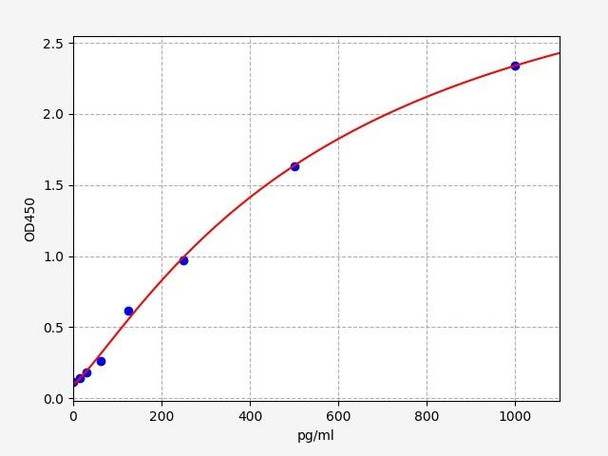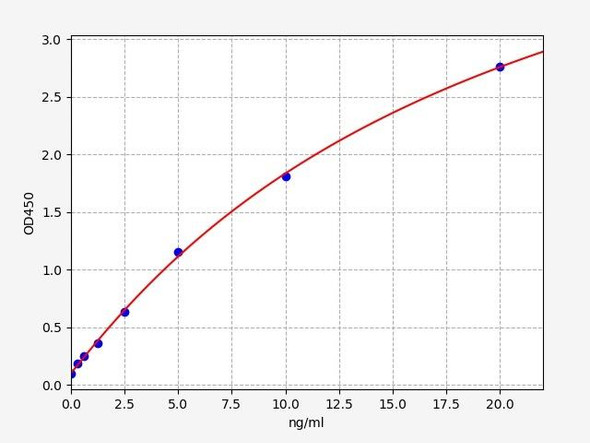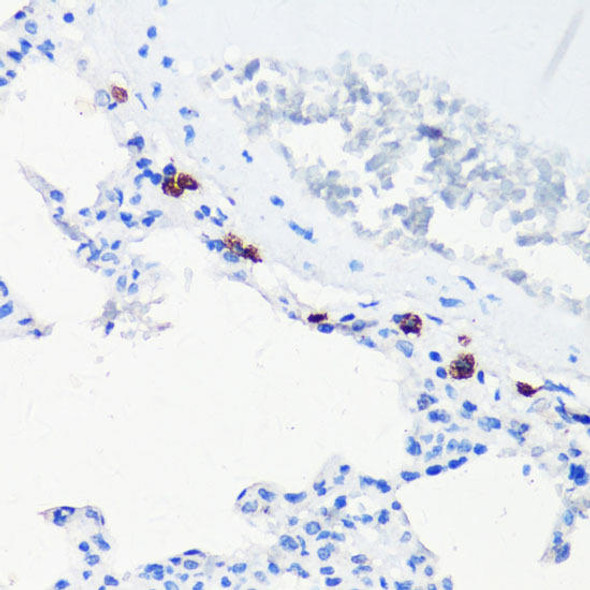Mouse HO-1/HMOX1/HSP32 ELISA Kit (MOFI00901)
- SKU:
- MOFI00901
- Product Type:
- ELISA Kit
- Size:
- 96 Assays
- Uniprot:
- P14901
- Sensitivity:
- 9.375pg/ml
- Range:
- 15.625-1000pg/ml
- ELISA Type:
- Sandwich
- Synonyms:
- HO1, HO-1, HMOX1, HSP32, heat shock protein, 32-kD, heme oxygenase, decycling 1, HO, HO1
- Reactivity:
- Mouse
- Research Area:
- Cell Death
Description
Mouse HO-1/HMOX1/HSP32 ELISA Kit
The Mouse HO-1 (HMOX1, HSP32) ELISA Kit is a powerful tool designed for the quantitative measurement of heme oxygenase-1 levels in mouse serum, plasma, and tissue lysates. This kit offers exceptional sensitivity and specificity, ensuring accurate and reproducible results for a variety of research applications.Heme oxygenase-1, also known as HMOX1 or HSP32, is a critical enzyme involved in the breakdown of heme, leading to the production of biliverdin, carbon monoxide, and iron. This process plays a crucial role in cellular defense against oxidative stress and inflammation, making heme oxygenase-1 a key player in various pathophysiological processes.
By accurately measuring heme oxygenase-1 levels, researchers can gain valuable insights into the mechanisms underlying oxidative stress, inflammation, and cellular homeostasis. This ELISA kit provides a reliable and efficient means of studying heme oxygenase-1 in mouse models, ultimately contributing to the development of novel therapeutic strategies for conditions such as cardiovascular diseases, neurodegenerative disorders, and cancer.
| Product Name: | Mouse HO-1/HMOX1/HSP32 ELISA Kit |
| Product Code: | MOFI00901 |
| Size: | 96 Assays |
| Alias: | HO1, HO-1, HMOX1, HSP32, heat shock protein, 32-kD, heme oxygenase, decycling 1, HO, HO1 |
| Detection Method: | Sandwich ELISA |
| Application: | This immunoassay kit allows for the in vitro quantitative determination of Mouse HO-1 concentrations in serum plasma and other biological fluids. |
| Sensitivity: | 9.375pg/ml |
| Range: | 15.625-1000pg/ml |
| Storage: | 4°C for 6 months |
| Note: | For Research Use Only |
| Recovery: | Matrices listed below were spiked with certain level of Mouse HO-1 and the recovery rates were calculated by comparing the measured value to the expected amount of Mouse HO-1 in samples. | ||||||||||||||||
| |||||||||||||||||
| Linearity: | The linearity of the kit was assayed by testing samples spiked with appropriate concentration of Mouse HO-1 and their serial dilutions. The results were demonstrated by the percentage of calculated concentration to the expected. | ||||||||||||||||
| |||||||||||||||||
| Intra Assay: | CV <8% | ||||||||||||||||
| Inter Assay: | CV <10% |
| Component | Quantity | Storage |
| ELISA Microplate (Dismountable) | 8×12 strips | 4°C for 6 months |
| Lyophilized Standard | 2 | 4°C/-20°C |
| Sample/Standard Dilution Buffer | 20ml | 4°C |
| Biotin-labeled Antibody(Concentrated) | 120ul | 4°C (Protect from light) |
| Antibody Dilution Buffer | 10ml | 4°C |
| HRP-Streptavidin Conjugate(SABC) | 120ul | 4°C (Protect from light) |
| SABC Dilution Buffer | 10ml | 4°C |
| TMB Substrate | 10ml | 4°C (Protect from light) |
| Stop Solution | 10ml | 4°C |
| Wash Buffer(25X) | 30ml | 4°C |
| Plate Sealer | 5 | - |
Other materials and equipment required:
- Microplate reader with 450 nm wavelength filter
- Multichannel Pipette, Pipette, microcentrifuge tubes and disposable pipette tips
- Incubator
- Deionized or distilled water
- Absorbent paper
- Buffer resevoir
| Uniprot | P14901 |
| UniProt Protein Function: | HMOX1: Heme oxygenase cleaves the heme ring at the alpha methene bridge to form biliverdin. Biliverdin is subsequently converted to bilirubin by biliverdin reductase. Under physiological conditions, the activity of heme oxygenase is highest in the spleen, where senescent erythrocytes are sequestrated and destroyed. Heme oxygenase 1 activity is highly inducible by its substrate heme and by various non-heme substances such as heavy metals, bromobenzene, endotoxin, oxidizing agents and UVA. Expressed at higher levels in renal cancer tissue than in normal tissue. Belongs to the heme oxygenase family. |
| UniProt Protein Details: | Protein type:Cofactor and Vitamin Metabolism - porphyrin and chlorophyll; Oxidoreductase; EC 1.14.99.3 Cellular Component: membrane; intracellular membrane-bound organelle; perinuclear region of cytoplasm; endoplasmic reticulum; nucleolus; caveola; cytosol; nucleus Molecular Function:signal transducer activity; enzyme binding; protein homodimerization activity; metal ion binding; phospholipase D activity; heme binding; oxidoreductase activity; heme oxygenase (decyclizing) activity Biological Process: response to nicotine; cell death; apoptosis; negative regulation of smooth muscle cell proliferation; negative regulation of mast cell degranulation; positive regulation of smooth muscle cell proliferation; heme metabolic process; negative regulation of cell proliferation; erythrocyte homeostasis; regulation of transcription factor activity; heme catabolic process; regulation of blood pressure; small GTPase mediated signal transduction; negative regulation of mast cell cytokine production; angiogenesis; negative regulation of neuron apoptosis; regulation of transcription from RNA polymerase II promoter in response to oxidative stress; healing during inflammatory response; protein homooligomerization; positive regulation of I-kappaB kinase/NF-kappaB cascade; negative regulation of transcription factor activity; heme oxidation; negative regulation of DNA binding; positive regulation of angiogenesis; iron ion homeostasis; DNA damage response, signal transduction resulting in induction of apoptosis; response to hydrogen peroxide; response to estrogen stimulus; response to oxidative stress |
| UniProt Code: | P14901 |
| NCBI GenInfo Identifier: | 6754212 |
| NCBI Gene ID: | 15368 |
| NCBI Accession: | NP_034572.1 |
| UniProt Related Accession: | P14901 |
| Molecular Weight: | 21.6kDa |
| NCBI Full Name: | heme oxygenase 1 |
| NCBI Synonym Full Names: | heme oxygenase (decycling) 1 |
| NCBI Official Symbol: | Hmox1 |
| NCBI Official Synonym Symbols: | HO1; HO-1; Hmox; Hemox; Hsp32; D8Wsu38e |
| NCBI Protein Information: | heme oxygenase 1; P32 protein; hemoxygenase |
| UniProt Protein Name: | Heme oxygenase 1 |
| UniProt Synonym Protein Names: | P32 protein |
| UniProt Gene Name: | Hmox1 |
| UniProt Entry Name: | HMOX1_MOUSE |
*Note: Protocols are specific to each batch/lot. For the correct instructions please follow the protocol included in your kit.
| Step | Procedure |
| 1. | Set standard, test sample and control (zero) wells on the pre-coated plate respectively, and then, record their positions. It is recommended to measure each standard and sample in duplicate. Wash plate 2 times before adding standard, sample and control (zero) wells! |
| 2. | Aliquot 0.1ml standard solutions into the standard wells. |
| 3. | Add 0.1 ml of Sample / Standard dilution buffer into the control (zero) well. |
| 4. | Add 0.1 ml of properly diluted sample (Human serum, plasma, tissue homogenates and other biological fluids.) into test sample wells. |
| 5. | Seal the plate with a cover and incubate at 37 °C for 90 min. |
| 6. | Remove the cover and discard the plate content, clap the plate on the absorbent filter papers or other absorbent material. Do NOT let the wells completely dry at any time. Wash plate X2. |
| 7. | Add 0.1 ml of Biotin- detection antibody working solution into the above wells (standard, test sample & zero wells). Add the solution at the bottom of each well without touching the side wall. |
| 8. | Seal the plate with a cover and incubate at 37°C for 60 min. |
| 9. | Remove the cover, and wash plate 3 times with Wash buffer. Let wash buffer rest in wells for 1 min between each wash. |
| 10. | Add 0.1 ml of SABC working solution into each well, cover the plate and incubate at 37°C for 30 min. |
| 11. | Remove the cover and wash plate 5 times with Wash buffer, and each time let the wash buffer stay in the wells for 1-2 min. |
| 12. | Add 90 µL of TMB substrate into each well, cover the plate and incubate at 37°C in dark within 10-20 min. (Note: This incubation time is for reference use only, the optimal time should be determined by end user.) And the shades of blue can be seen in the first 3-4 wells (with most concentrated standard solutions), the other wells show no obvious color. |
| 13. | Add 50 µL of Stop solution into each well and mix thoroughly. The color changes into yellow immediately. |
| 14. | Read the O.D. absorbance at 450 nm in a microplate reader immediately after adding the stop solution. |
When carrying out an ELISA assay it is important to prepare your samples in order to achieve the best possible results. Below we have a list of procedures for the preparation of samples for different sample types.
| Sample Type | Protocol |
| Serum: | If using serum separator tubes, allow samples to clot for 30 minutes at room temperature. Centrifuge for 10 minutes at 1,000x g. Collect the serum fraction and assay promptly or aliquot and store the samples at -80°C. Avoid multiple freeze-thaw cycles. If serum separator tubes are not being used, allow samples to clot overnight at 2-8°C. Centrifuge for 10 minutes at 1,000x g. Remove serum and assay promptly or aliquot and store the samples at -80°C. Avoid multiple freeze-thaw cycles. |
| Plasma: | Collect plasma using EDTA or heparin as an anticoagulant. Centrifuge samples at 4°C for 15 mins at 1000 × g within 30 mins of collection. Collect the plasma fraction and assay promptly or aliquot and store the samples at -80°C. Avoid multiple freeze-thaw cycles. Note: Over haemolysed samples are not suitable for use with this kit. |
| Urine & Cerebrospinal Fluid: | Collect the urine (mid-stream) in a sterile container, centrifuge for 20 mins at 2000-3000 rpm. Remove supernatant and assay immediately. If any precipitation is detected, repeat the centrifugation step. A similar protocol can be used for cerebrospinal fluid. |
| Cell culture supernatant: | Collect the cell culture media by pipette, followed by centrifugation at 4°C for 20 mins at 1500 rpm. Collect the clear supernatant and assay immediately. |
| Cell lysates: | Solubilize cells in lysis buffer and allow to sit on ice for 30 minutes. Centrifuge tubes at 14,000 x g for 5 minutes to remove insoluble material. Aliquot the supernatant into a new tube and discard the remaining whole cell extract. Quantify total protein concentration using a total protein assay. Assay immediately or aliquot and store at ≤ -20°C. |
| Tissue homogenates: | The preparation of tissue homogenates will vary depending upon tissue type. Rinse tissue with 1X PBS to remove excess blood & homogenize in 20ml of 1X PBS (including protease inhibitors) and store overnight at ≤ -20°C. Two freeze-thaw cycles are required to break the cell membranes. To further disrupt the cell membranes you can sonicate the samples. Centrifuge homogenates for 5 mins at 5000xg. Remove the supernatant and assay immediately or aliquot and store at -20°C or -80°C. |
| Tissue lysates: | Rinse tissue with PBS, cut into 1-2 mm pieces, and homogenize with a tissue homogenizer in PBS. Add an equal volume of RIPA buffer containing protease inhibitors and lyse tissues at room temperature for 30 minutes with gentle agitation. Centrifuge to remove debris. Quantify total protein concentration using a total protein assay. Assay immediately or aliquot and store at ≤ -20 °C. |
| Breast Milk: | Collect milk samples and centrifuge at 10,000 x g for 60 min at 4°C. Aliquot the supernatant and assay. For long term use, store samples at -80°C. Minimize freeze/thaw cycles. |









